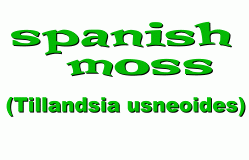 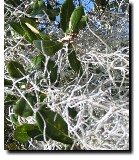 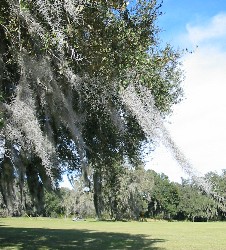 When we were in Florida we were immediately aware of something different about the trees. Most of them were draped with long strands of plant-like material, and we weren't sure what it was.
When we were in Florida we were immediately aware of something different about the trees. Most of them were draped with long strands of plant-like material, and we weren't sure what it was. It seemed to be everywhere, not only covering the trees, but also hanging from telephone wires, fences, and occasionally even roofs. A local resident informed us that this was Spanish Moss. Not being familiar with this type of plant, we immediately assumed it must be some sort of parasite. Is it really a moss? Does it live on nutrients it receives from the trees? What does it look like up close? We did a little research, and were amazed at what we learned. We'll share it with you here, along with some pictures we took of this amazing plant. 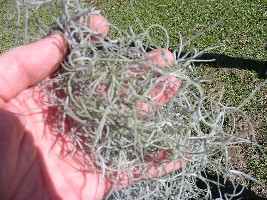 Spanish moss grows from trees as a silvery-grey threadlike mass, which can be up to to 8 metres long. Individual strands are densely covered by grey scales, which help conserve moisture. In season, small 1 cm wide flowers with yellowish-green to blue petals appear on the strands.
Spanish moss grows from trees as a silvery-grey threadlike mass, which can be up to to 8 metres long. Individual strands are densely covered by grey scales, which help conserve moisture. In season, small 1 cm wide flowers with yellowish-green to blue petals appear on the strands.The first thing we discovered is that Spanish Moss is not a true moss at all, but is actually more closely related to the pineapple tree! Moreover, it is not a parasite! While it clings to the tree for support, it is not directly attached, and receives no nourishment from the tree. Rather, Spanish Moss is an epiphyte. Epiphytes do not draw nutrients from the host plant, but absorb water and food from the air directly though their stems and leaves. Through the process of photosynthesis, just as in ordinary plants, the chlorophyll in the epiphyte converts water and CO2 into carbohydrates. Other examples of epiphytes include some tropical orchids, and some ferns. Spanish Moss can be found in the U.S. from Virginia southwards, and all the way down to Argentina in South America. Native Americans called the plant 'tree hair', a name which the French explorers turned to 'Barbe espagnole', or 'Spanish Beard', to insult their Spanish rivals in the New World. The Spanish in turn named it 'Cabello francés' ('French hair'). 'Spanish Moss', a milder variation of the French insult, has survived. Another common name is 'Graybeard'. 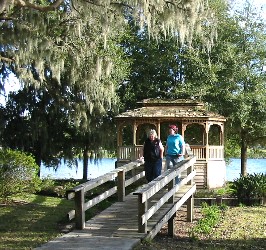 When wet, the plant has a greenish color. The plant flowers from April to July. After fertilization, the blossoms produce pods bearing sail-like seeds that become airborne when released, and which stick fast to tree branches. The seeds lodge in the cracks of rough-barked live oaks, where a seedling can fasten temporary roots to keep it in place.
When wet, the plant has a greenish color. The plant flowers from April to July. After fertilization, the blossoms produce pods bearing sail-like seeds that become airborne when released, and which stick fast to tree branches. The seeds lodge in the cracks of rough-barked live oaks, where a seedling can fasten temporary roots to keep it in place.
Small stems grows after about two weeks, and these stems will extract most of the plant’s nutrients from its surroundings. The plant will also absorb some nutrients from matter that has decayed on the tree. The plant’s external scales may also absorb minerals from tree leaves. A host tree may suffer if a particularly thick growth of moss blocks out sunlight, but Spanish Moss normally does no harm to the trees it hangs from. However, Spanish Moss can absorb water up to ten times its own weight, and will often crack the branch on which it has grown after a particularly heavy rainfall. Strangely, despite the fact that the plant does not physically attach itself to trees, the moss will grow only on trees, and not on fences, telephone poles, buildings or even on vines; whatever clumps of Spanish Moss happen to be found on these surfaces have fallen there, or have been blown from trees by the wind. 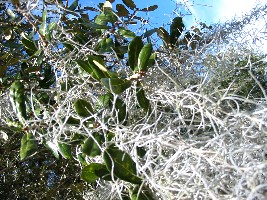 Spanish Moss creates an ecosystem that shelters many creatures, including chiggers, rat snakes, and three species of bats. One species of spider, Pelegrina tillandsiae, lives only in Spanish Moss. We weren't aware of this when we were examining strands of the moss and taking these pictures; fortunately the strands we held seemed to be free of inhabitants! Birds also use Spanish Moss to build or hide their nests, and the parula warbler makes its nest in the actual hanging clumps of the moss. Squirrels, owls, egrets and mockingbirds also use Spanish Moss for nest bedding. 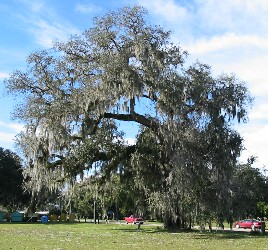 The first people to settle in the southern U.S. tried to use Spanish Moss as food for their animals. But, although Spanish Moss can be stored like hay for the winter months, it has very little food value, and is useful only as a bulk feed.
The first people to settle in the southern U.S. tried to use Spanish Moss as food for their animals. But, although Spanish Moss can be stored like hay for the winter months, it has very little food value, and is useful only as a bulk feed. Colonists also mixed moss and mud together to make the walls of their cabins. Dried moss also made good kindling for the fireplace. Commercial uses for Spanish Moss have included packing material, saddle blankets, bridles, braids, and twine to repair fishermen’s nets. Apparently Henry Ford stuffed the seats in his first Model Ts with Spanish Moss. Nowadays, Spanish Moss is mostly used just for arts and crafts. But scientists have also discovered that testing samples of the moss, especially ones that hang near major highways, can measure how much air pollution exists, since the plant will absorb such heavy metals as lead, copper, nickel, and manganese from the air along with its nutrients. |